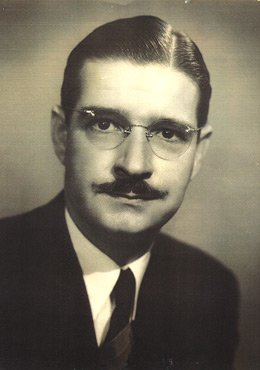Roy C. Crane Jr
Cartoonist, Ex 1919
 Roy Crane, creator of Wash Tubbs and Buz Sawyer, has been called the father of the adventure story cartoon strip. Some of Crane’s earliest sketches were done in 1918 and 1919 here on the HSU campus and were featured in the student newspaper and in the yearbook.
Roy Crane, creator of Wash Tubbs and Buz Sawyer, has been called the father of the adventure story cartoon strip. Some of Crane’s earliest sketches were done in 1918 and 1919 here on the HSU campus and were featured in the student newspaper and in the yearbook.
Royston Campbell Crane Jr. was born in Abilene, Texas, on November 22, 1901, the only child surviving infancy of Judge R. C. and Mamie Douthit Crane. In 1903, the Crane family relocated to Sweetwater, Texas, where Roy began to develop into a remarkable and imaginative artist. In 1915, Crane’s father enrolled Roy in the Charles N. Landon correspondence art course based in Cleveland, Ohio, to bring discipline and balance to the 13-year-old’s still unfettered talent.
Crane graduated from Sweetwater High School in 1918, where he contributed to the school’s yearbook. Following graduation, with World War I drawing to an exciting close, 16-year-old Roy tried to enlist in the Army. He was denied enlistment by the recruiting officer who knew Roy’s father, Judge Crane, very well. That summer, Roy joined local businessmen who helped work on the cotton farms of families whose sons were away in service. In the fall, Roy convinced his father to let him attend Simmons College, which was to have a Student Army Training Corps. Although he was too young to join the Corps, Crane bought a uniform, received military training with the others, and became a college freshman at 16.
Crane left a sizable legacy of caricatures and biting gag lines in the 1918-1919 edition of the HSU yearbook, The Bronco, that uniquely captured the prevailing politics and campus mood during his initial collegiate experience. The Brand became the first college newspaper to publish a Crane cartoon on December 13, 1918.
After attending Simmons for two semesters, Crane worked as an artist and reporter for several newspapers and magazines, attended the Chicago Academy of Fine Arts, and later became a journalism student at the University of Texas.
In 1922, Crane sailed for France and Belgium, leaving the Lone Star State and his elusive degree behind. After a number of harrowing experiences abroad and on board ship, Crane docked in New York City where he found employment at the New York World. There he was a member of the art department and assistant to cartoonist H. T. Webster.
During this time, Crane began trying to get published, sending his cartoon sketches to syndicates. His former mail-order art instructor, Charles N. Landon, had become art director for the Newspaper Enterprise Association syndicate, and it was he who approved the comic strip, Washington Tubbs II, which debuted in 1924 and eventually established Roy Crane as an internationally famous cartoonist.
In 1928, Crane married the former Evelyn Cecila Hatcher, and the couple had two daughters, Marcia and Nancy.
Crane’s popular strip was already widely imitated by 1929 when Crane introduced the Captain Easy character as a sidekick to Wash Tubbs. In 1933, the Captain got a series of his own, Captain Easy, Soldier of Fortune.
In 1943, Crane launched Buz Sawyer, which in a few short years was carried by 550 newspapers in 10 countries and was read by an estimated 40 million people daily. The U. S. Navy, pleased with the publicity it received from Buz Sawyer’s adventures as a reservist on active duty, recognized Crane with a plaque commemorating his visit aboard the Carrier Independence. In 1944, he was honored by Rear Admiral A. W. Radford, acting deputy chief of Naval Operations, for his support of World War II through his comic strips. He also received the Gold Medal Award for Distinguished Public Service from the U. S. Navy in 1957 and received a commendation as an accredited war correspondent.
In 1950, Crane became the fifth recipient of the Billy De Beck Memorial Award, which later became the Reuben Award that is given annually to the cartoonist of the year by the National Cartoon Society. He received numerous industry awards throughout his distinguished career as a cartoonist, and in 1957 was awarded an honorary doctorate by Rollins College in Winter Park, Florida. In 1969, he receive a Distinguished Alumnus Award from the University of Texas.
Crane was a member of the National Cartoonists’ Society, the Aviation-Space Writers Association, was an honorary member of the U. S. Navy League, and was listed in Who’s Who in America. In 1965, Crane established the Roy Crane Award for Outstanding Creative Achievement in the Arts at the University of Texas.
Crane continued to take an active part in the daily production of his famous strip until his death on July 8, 1977, at the age of 76.
It is the high honor of Hardin-Simmons University to recognize one of her own and to formally induct Royston Campbell Crane Jr. into the HSU Hall of Leaders.



